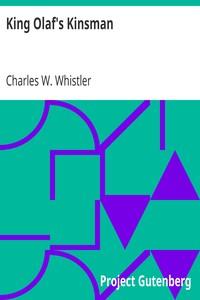|
|
Read this ebook for free! No credit card needed, absolutely nothing to pay.Words: 97568 in 52 pages
This is an ebook sharing website. You can read the uploaded ebooks for free here. No credit cards needed, nothing to pay. If you want to own a digital copy of the ebook, or want to read offline with your favorite ebook-reader, then you can choose to buy and download the ebook.

: King Olaf's Kinsman A Story of the Last Saxon Struggle against the Danes in the Days of Ironside and Cnut by Whistler Charles W Charles Watts - Olav II King of Norway 995-1030 Fiction Historical Fiction@FreeBooksTue 06 Jun, 2023 KING OLAF'S KINSMAN A Story of the Last Saxon Struggle Against the Danes in the Days of Ironside and Cnut by Charles W. Whistler PREFACE No English chronicler mentions the presence of King Olaf the Saint in England; but the two churches dedicated to him at either end of London Bridge, where his greatest deed was wrought, testify to the gratitude of the London citizens towards the viking chief who rescued their city from the Danes, and brought back the king of their own race towards whom their loyalty was so unswerving. The deeds of King Olaf recorded in this story of his kinsman are therefore from the Norse "Saga of King Olaf the Holy," and the various incidents are assigned as nearly as may be to their place in the sequence of events given from the death of Swein to the accession of Cnut, in the contemporary Anglo-Saxon Chronicle, which is our most reliable authority for the period. The place where King Olaf fought his seventh battle, "Ringmereheath in Ulfkyl's land," is doubtful. To have localized it, therefore, on a traditional battlefield in Suffolk, where a mound and field names point to a severe forgotten fight in the line which a southern invader would take between Colchester and Sudbury, may be pardonable for the purposes of Redwald's story. With regard to other historic incidents in the tale, some are from the Danish "Knytlinga" and "Jomsvikinga" Sagas, which alone give us the age of Cnut on his accession to the throne, and recount the interception of Queen Emma by Thorkel's men on her projected flight. In the ordinary course of history the age of the wise king is disregarded, and the doings of the three great jarls are naturally enough credited to him, for after the first few years of confusion have been passed over, he takes his place as the greatest of our rulers since Alfred, and his age is forgotten in his wonderful policy. The doings of Edric Streone are partly from the hints give by the Anglo-Saxon Chronicle, and partly from the accounts of later English writers. But there is no chronicle of either English, Danish, or Norse origin which does not hold him and his treachery in the utmost scorn. The account of the battle of Ashingdon follows the definite local traditions of the place. The line of the river banks have changed but little, and Cnut's earthworks still remain at Canewdon. The first battlefield is yet known, and they still tell how Eadmund was forced to fight on Ashingdon hill because his way across the ford was barred by the Danish ships, and how the pursuit of the routed English ended at Hockley. Wulfnoth and his famous son Godwine are of course historic. The Anglo-Saxon Chronicle tells us how the earl was driven into sullen enmity with Ethelred by Streone's brother, and the Danish Sagas record Godwine's first introduction by Jarl Ulf to Cnut after the battle of Sherston. As for the places mentioned in Redwald's story, the well on Caldbec hill still has its terrors for the village folk, and the destruction of the ancient mining village at Penhurst by the Danes is remembered yet with strange tales of treasure found among its stone buildings. The Bures folk still speak of the White Lady of the Mere, and their belief that Boadicea lies under the great mound is by no means unlikely to be a tradition of her true resting place. Free books android app tbrJar TBR JAR Read Free books online gutenberg More posts by @FreeBooks
: Corporal Sam and Other Stories by Quiller Couch Arthur - Short stories English@FreeBooksTue 06 Jun, 2023

: Notes and Queries Number 16 February 16 1850 by Various - Questions and answers Periodicals Notes and Queries@FreeBooksTue 06 Jun, 2023

: Parnaso Filipino Antología de Poetas del Archipelago Magellanico by Mart N De La C Mara Eduardo - Philippines Biography; Philippine poetry (Spanish)@FreeBooksTue 06 Jun, 2023
|
Terms of Use Stock Market News! © gutenberg.org.in2025 All Rights reserved.






